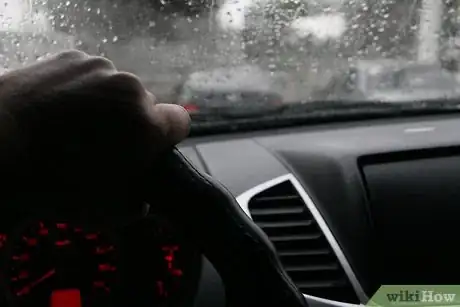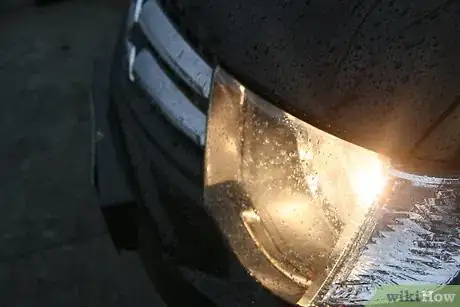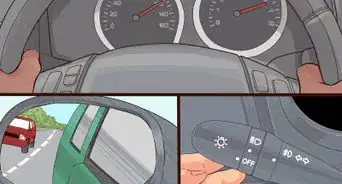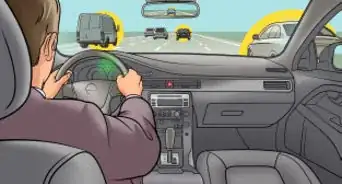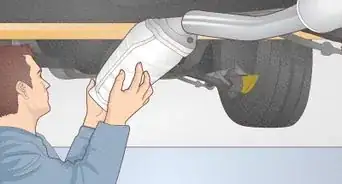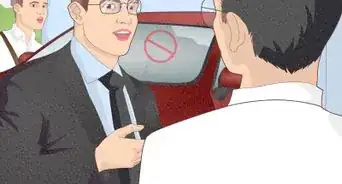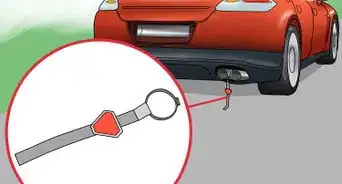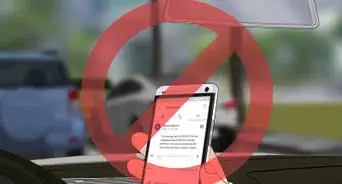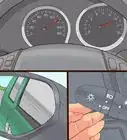wikiHow is a “wiki,” similar to Wikipedia, which means that many of our articles are co-written by multiple authors. To create this article, 19 people, some anonymous, worked to edit and improve it over time.
There are 8 references cited in this article, which can be found at the bottom of the page.
wikiHow marks an article as reader-approved once it receives enough positive feedback. In this case, 92% of readers who voted found the article helpful, earning it our reader-approved status.
This article has been viewed 300,795 times.
Learn more...
Fog is one of the scariest things to drive in, especially if you're unfamiliar with it. It is a dense "cloud bank" that rests on the ground. Here is how to drive safely in fog.
Steps
-
1Be aware of local weather conditions. Fog is often a morning or evening weather phenomena, so if possible, avoid driving during these times. Also be aware of local areas that tend to accumulate fog, like certain seaside areas, and other low lying areas near lakes and rivers.
-
2Allow more distance between vehicles. Increase your count distance by 5 seconds instead of the normal 2 seconds behind another vehicle. Never rush or speed to get out of the fog.[1]Advertisement
-
3Use caution at all times. The moisture in the air may continuously collect on the windshield, making it more difficult to see. Adjust the defroster and windshield wiper speed as necessary.
-
4Use fog lights or driving lights (if equipped). Many vehicles have fog or driving lights that were installed at the factory. These lights are usually mounted low, in or below the front bumper. They are aimed toward the ground out in front of the vehicle as far as possible. Fog lights mainly differ from driving lights in the way they project the light. Fog lights often have clear or yellow lenses; while driving lights usually have clear lenses. The beam of light created by fog lights is usually wide and flat pattern; flat to stay close the road surface and minimize reflection back by fog - and wide to better illuminate the sides of the roadway (guard rails, curbs, lines painted on the roadway, etc.). Driving lights are usually merely bright spot lights designed to pierce the night darkness further than regular headlights. While fog lights are best for foggy conditions, either type of light will likely perform better than headlights due to their low mounting point on the vehicle. Experiment using all combinations (if possible) of fog / driving lights "on" and the low beam headlights "on" or "off" to determine which setting provides the best forward visibility for the driver. Do not shut off the running or "parking" lights, as they help make your vehicle more visible to other drivers alongside and behind your vehicle.[2]
-
5Use your low beams. The visibility in front of you will sharply decrease in a fog, so use the vehicle's low beam lights (if the vehicle does not have fog lights or driving lights). Heavy fog conditions prohibit use of high beam headlights. The light from high beam headlights will be reflected back by thick fog. As fog thins, high beams can become more effective. Check periodically to see if the fog has thinned enough to make use of high beams.[3]
-
6Don't drift. There's a natural tendency to wander into the middle of the road when visibility gets bad. Be sure to keep yourself in your lane.[4]
-
7Beware of critters. Animals--especially white tail deer--feel bolder under cover of fog and are much harder to see.[5]
-
8Beware of Freezing Fog. In some climates, fog near the freezing point can freeze on contact with cold surfaces--including roads! This can cause black ice.[6]
-
9Pull over to the side of the road if you have no visibility. If it gets too difficult or thick, pull over and wait. Turning on your hazard lights alerts other drivers of where you are.[7]
-
10Use the right edge of the road as a guide. This can help you avoid running into oncoming traffic or being blinded by oncoming headlights.[8]
-
11Ask for help. Don't be afraid to ask your passengers to help keep an eye out for oncoming cars and obstacles on the road.
Community Q&A
-
QuestionShould I use my high beams in fog?
 Community AnswerYou shouldn't. The light of your high beams will be refracted and reflected by the fog, making it even more difficult to see. Many headlight assemblies include lights called fog lights, which point down toward the road out in front of the vehicle, illuminating the road in foggy conditions. If your car doesn't have these, use your low beams.
Community AnswerYou shouldn't. The light of your high beams will be refracted and reflected by the fog, making it even more difficult to see. Many headlight assemblies include lights called fog lights, which point down toward the road out in front of the vehicle, illuminating the road in foggy conditions. If your car doesn't have these, use your low beams. -
QuestionHow can I improve at driving in a fog?
 Community AnswerIf your vehicle has fog lights, turn them on. If not, leave your lights on low beam as the high beam setting can throw the light right back at you. Drive five under the posted speed limit to give yourself more reaction time in case of an emergency. If you need to pull over, remember to put your vehicle in park and keep your foot off the brake as your brake light will confuse those behind you, and they'll attempt to follow, thinking you're still on the road.
Community AnswerIf your vehicle has fog lights, turn them on. If not, leave your lights on low beam as the high beam setting can throw the light right back at you. Drive five under the posted speed limit to give yourself more reaction time in case of an emergency. If you need to pull over, remember to put your vehicle in park and keep your foot off the brake as your brake light will confuse those behind you, and they'll attempt to follow, thinking you're still on the road. -
QuestionWhen parking on a hill, which way should I turn my wheels?
 Community AnswerTurn them towards the curb. That way, if the car starts rolling, it will go into the curb and stop. If there is no curb, turn them in the safest direction.
Community AnswerTurn them towards the curb. That way, if the car starts rolling, it will go into the curb and stop. If there is no curb, turn them in the safest direction.
Warnings
- Don't drive if you can't see.⧼thumbs_response⧽
- Never stop in the middle of the road!⧼thumbs_response⧽
- Avoid using your high beams as they could reflect off the fog and temporarily blind you!⧼thumbs_response⧽
References
- ↑ https://driving-tests.org/beginner-drivers/what-to-do-when-driving-in-fog/
- ↑ https://www.youtube.com/watch?v=3WyekTLxHhQ
- ↑ https://www.youtube.com/watch?v=BuK2Py4OaVs
- ↑ http://www.mto.gov.on.ca/english/trucks/handbook/section3-4-4.shtml
- ↑ https://www.youtube.com/watch?v=BuK2Py4OaVs
- ↑ https://www.osv.ltd.uk/tips-for-driving-in-fog-how-to-drive-safely-in-foggy-weather/
- ↑ https://www.weather.gov/safety/fog-driving
- ↑ https://www.drive-safely.net/driving-in-fog/
- Defensive Driving Online Safe Driver Resources

